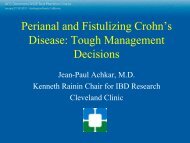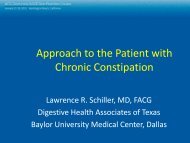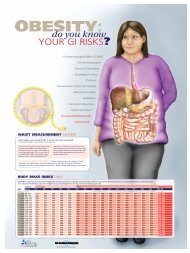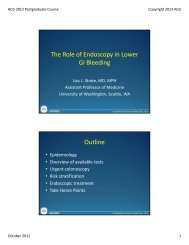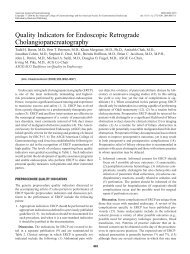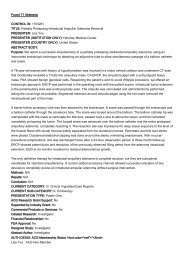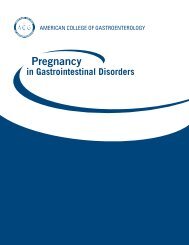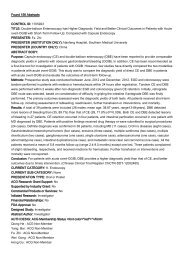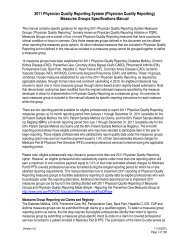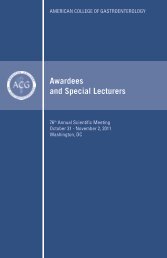Ensuring Competence in Endoscopy - American College of ...
Ensuring Competence in Endoscopy - American College of ...
Ensuring Competence in Endoscopy - American College of ...
Create successful ePaper yourself
Turn your PDF publications into a flip-book with our unique Google optimized e-Paper software.
specialist is nationwide.” 18 The criteria <strong>of</strong> medical specialty societies also<br />
become highly relevant, s<strong>in</strong>ce they not only provide reliable <strong>in</strong>dicia <strong>of</strong><br />
national consensus, but also def<strong>in</strong>e the very class <strong>of</strong> “specialists” who are<br />
uniquely capable <strong>of</strong> perform<strong>in</strong>g certa<strong>in</strong> procedures and ma<strong>in</strong>ta<strong>in</strong><strong>in</strong>g the<br />
required standard <strong>of</strong> care. The follow<strong>in</strong>g sections exam<strong>in</strong>e JCAHO standards<br />
and pert<strong>in</strong>ent specialty society guidel<strong>in</strong>es.<br />
JCAHO Accreditation Standards. JCAHO, established <strong>in</strong> 1952, acts as a<br />
nationwide accreditation board for hospitals. While hospitals need not be<br />
accredited by JCAHO to provide health care, a large majority <strong>of</strong> hospitals<br />
seek JCAHO accreditation because participation <strong>in</strong> Medicare and Medicaid,<br />
as well as recognition <strong>of</strong> <strong>in</strong>tern and residency programs, generally<br />
depends on JCAHO accreditation. 19 The purpose <strong>of</strong> JCAHO is “to establish<br />
m<strong>in</strong>imum hospital standards for patient care.” 20<br />
JCAHO annually publishes a manual that conta<strong>in</strong>s a plethora <strong>of</strong> guidel<strong>in</strong>es<br />
address<strong>in</strong>g many hospital functions, from adm<strong>in</strong>istrative organization to<br />
specific forms <strong>of</strong> care. 21 Each section <strong>of</strong> the manual sets forth broad “Standards,”<br />
and every Standard is further def<strong>in</strong>ed by a “Rationale” as well as<br />
“Elements <strong>of</strong> Performance,” i.e., what it means to comply with the Standards.<br />
Of particular relevance is the section deal<strong>in</strong>g with the credential<strong>in</strong>g,<br />
privileg<strong>in</strong>g, and appo<strong>in</strong>tment <strong>of</strong> medical staff. 22<br />
Credential<strong>in</strong>g is the first step <strong>in</strong> the process that leads to privileg<strong>in</strong>g. It<br />
<strong>in</strong>volves “process<strong>in</strong>g applications, verify<strong>in</strong>g credentials, evaluat<strong>in</strong>g applicant-specific<br />
<strong>in</strong>formation, and mak<strong>in</strong>g recommendations to the govern<strong>in</strong>g<br />
body for appo<strong>in</strong>tment and privileges.” 23 The purpose <strong>of</strong> verify<strong>in</strong>g credentials<br />
data is to ensure the follow<strong>in</strong>g: (1) the <strong>in</strong>dividual request<strong>in</strong>g privileges<br />
is <strong>in</strong> fact the same <strong>in</strong>dividual who is identified <strong>in</strong> the credential<strong>in</strong>g documents;<br />
(2) the applicant has atta<strong>in</strong>ed the credentials as stated; (3) the credentials<br />
are current; and (4) there are no challenges to any <strong>of</strong> the<br />
credentials. 24 Required <strong>in</strong>formation <strong>in</strong>cludes “data on qualifications such as<br />
licensure and tra<strong>in</strong><strong>in</strong>g or experience.” 25 Relevant tra<strong>in</strong><strong>in</strong>g or experience “is<br />
def<strong>in</strong>ed by the specific circumstances <strong>of</strong> the applicant, requir<strong>in</strong>g that the<br />
hospital believes there is sufficient <strong>in</strong>formation on which to base a reasoned<br />
decision.” 26 Ideally, such <strong>in</strong>formation should come from a “primary<br />
source,” which is “the orig<strong>in</strong>al source <strong>of</strong> the specific credential that can be<br />
used to verify the accuracy <strong>of</strong> a credential reported by the practitioner,”<br />
such as “for example, the specialty certify<strong>in</strong>g boards approved by the <strong>American</strong><br />
Dental Association for a dentist’s board certification, and letters from<br />
pr<strong>of</strong>essional schools . . . and from residency or postdoctoral programs for<br />
18. Cudnik v. William Beaumont Hosp., 525 N.W.2d 891, 894 (Mich. Ct. App. 1994).<br />
19. See Johnson, 301 N.W.2d at 159 n. 8 (1981).<br />
20. Note, Hospital Corporate Liability, at 369 n. 194.<br />
21. See JOINT COMMISSION ON ACCREDITATION OF HEALTHCARE ORGANIZATIONS, COMPRE-<br />
HENSIVE ACCREDITATION MANUAL FOR HOSPITALS: THE OFFICIAL HANDBOOK (2004)<br />
(here<strong>in</strong>after JCAHO MANUAL).<br />
22. See id. at MS-3.<br />
23. Id. at MS-16.<br />
24. Id. at MS-17.<br />
25. Id. at MS-16.<br />
26. Id. at MS-17.<br />
18 <strong>Ensur<strong>in</strong>g</strong> <strong>Competence</strong> <strong>in</strong> <strong>Endoscopy</strong>



